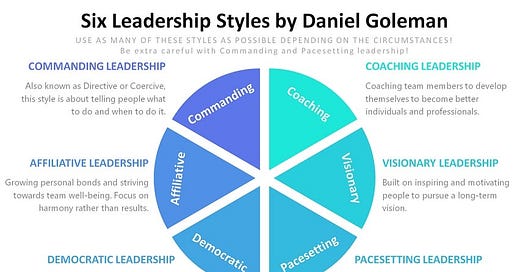Is Your Leadership Style Hurting Your Team?
Discover the 6 leadership styles from expert Daniel Goleman and see which ones could be damaging your team's morale and performance - plus how to quickly adapt your approach.
"“You matter.” That is all. And that is everything. When we know that we matter, we think at our best."― More Time to Think: The power of independent thinking.
Feel too personal? Based on the stats, we want to matter in the workplace too, especially in the eye’s of our leaders.
The majority (86%) of employees believe empathetic leadership boosts morale while 87% of employees say empathy is essential to fostering an inclusive environment, according to E&Y.
Harvard Business Review shares 55% of leaders overestimate how empathetic and compassionate they are, which may point to a gap in understanding what it means to demonstrate empathy in the workplace.
A recent survey found that 52% of respondents feel their company’s efforts to be empathetic towards employees are dishonest.
And for those who like visuals, we have:
The stats are hitting pretty close to home, based on what I hear in my coaching and facilitating:
I dread Sunday evenings as I have to go to work tomorrow.
I’m just waiting for my boss to yell at me again.
I never meet with my boss as they don’t have any time for me.
My boss just tells me to ‘get on with it’, without letting me know what “it” is.
How does empathy apply to a leader? An empathic leader is a leader who demonstrates care, concern, and understanding for their employees. They apply a leadership style which makes their employees feel heard and that they matter.
Today we explore different types of leadership styles. As you read, keep in mind the stats and statements above. Consider the type of leader you are or work with today and the type of leader you want to become.
What leadership styles to apply and when
In a Harvard Business Review article in 2000, Daniel Goleman (psychologist, author, originator of emotional intelligence) introduced the concept of six leadership styles. I love the sentiment at the start of the article.
Ask any group of seasoned business people the question, “What should leaders do?” You’ll likely hear one response: the leader’s singular job is to get results. But how?
To answer the “how” and achieve results in a way that is sustainable, Daniel Goleman gives us six options.
It’s not one size, fits all. Leaders should adapt their approach based on the circumstances such as the situation, people involved, and topic. Think of a sports team. You are going to call on certain styles of players when a penalty shot is being taken vs. standard back and forth play.
To simplify further, there are two general principles to follow.
It's best to use pacesetting and commanding styles sparingly. Sustained use of these styles undermines the trust, collaboration, and learning essential for long-term success and a positive work culture. Yes, there are short bursts of time when these approaches are necessary. The widespread IT outage caused by a faulty update to CrowdStrike’s security software comes to mind. Yet, these occasions are exceptional and out of the norm.
Visionary, democratic, affiliative, and coaching leadership styles aim to engage, motivate, and empower team members. These four styles build stronger teams by getting people more involved, helping them grow, and making them feel part of something bigger - all of which produce results that can be maintained and sustained over a longer period of time. As a coach and product leader, I've observed how these styles help draw out team insights and enable PMs to move through challenges more effectively together and with stakeholders.
Remember our strengths can also become our weaknesses. For example, I worked for an Affiliative leader. He was lots of fun and sought to be the center of attention at team events and holiday parties. Unfortunately he lacked the other leadership styles, meaning his team had to dial up our contributions to cover for him.
Wondering if your manager also is stuck in a loop on one approach? They don’t have to be. We can gain empathy and change our styles due to neuroplasticity, which is the ability of neural networks in the brain to change through awareness and practice. Trick is, your manager must want to change and move out of their fixed mindset.
“Being a great leader means recognizing that different circumstances
may call for different approaches.” (link)
Proactive leaders adapt now to avoid crisis
We know today’s leaders are seeking to do more with less. What happens if your company or leader is under pressure? I’ve been in this situation too.
A financially savvy CEO hired a seasoned CMO. It quickly became apparent that her default leadership style was Commanding. She yelled at her team constantly, in 1:1 and group settings. Despite calls to HR about her behavior, the CEO did nothing as he needed her expertise. Then the company was bought, and a new board brought in. One of the first actions was to let go of the CMO.
By retaining the CMO, the CEO was indicating to succeed you needed a leadership style which demoralized your people. That might work in the short term as noted with the Commanding leadership style, yet it is not sustainable for the long term. It discourages divergent ideas and stifles innovation, which the board recognized and led to the CMO’s departure.
“I’ve learned that people will forget what you said, people will forget what you did, but people will never forget how you made them feel,” poet and writer Maya Angelou.
Urgency can be a powerful motivator to rethink and reframe leadership strategies. But why wait for the situation to become urgent? You don’t have to. Instead proactive leaders can anticipate challenges and adapt their leadership style before they reach a crisis point.
Think about what type of leader you want to be - now and for the future. Book a call to explore your untapped potential. We know why today’s leaders are seeking to do more with less. What’s key is the “how”. There are different ways to get results. You can empower your team in way that shows they matter. Or, you can put aside the human factors and keep pushing people to their limits.
What type of leader do you aspire to be? Would you consider Lancaster a model leader?







